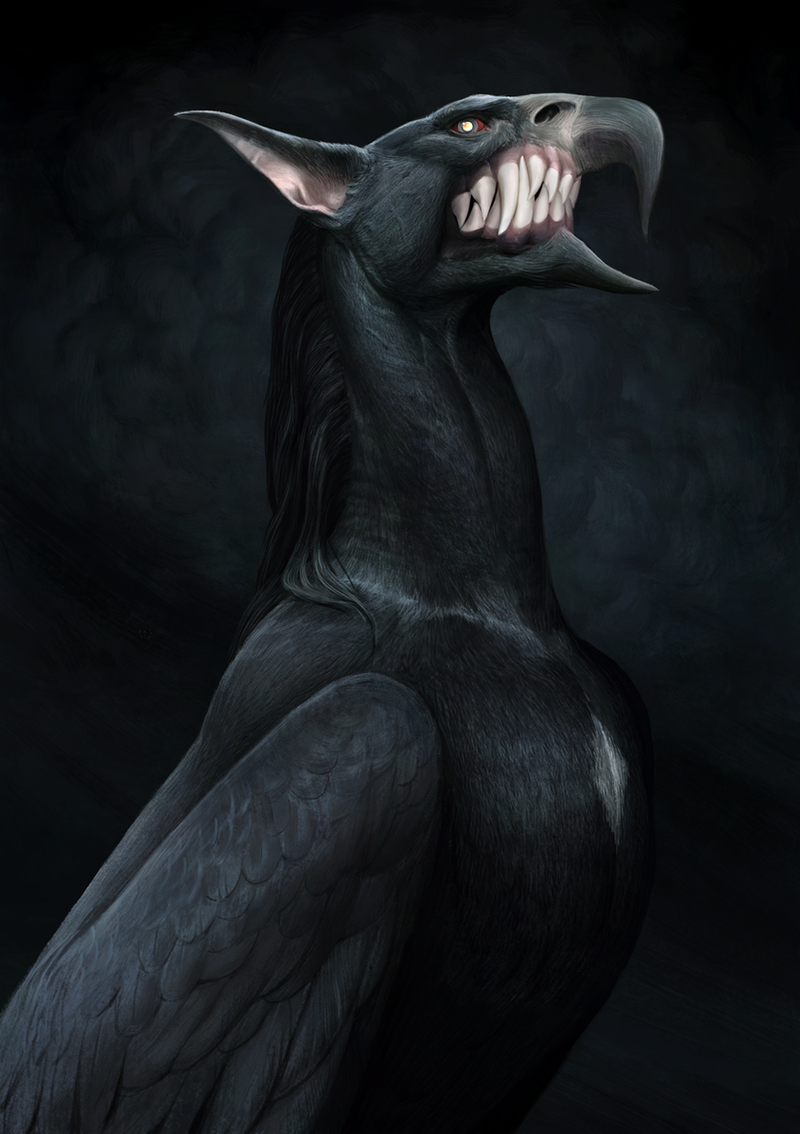Aver Brand
Mercicle

OUT OF CHARACTER INFORMATION
Intent: Bring more nasty wildlife to Thral.
Image Credit: Atenebrishttps://atenebris.deviantart.com/
Canon: /
Links: /
Name: Astetor
Designation: Non-sentient
Homeworld: Thralhttp://starwarsrp.net/topic/114631-thral-a-death-worldresubmission/
Language: Tweets
Average Lifespan: 40
Estimated Population: Planetary
Description: It’s like the Revenge of the Chickens 3 protagonist was an actual bird. Or, you know, birds. Plural. A fantastic product of nature, evolution (and, perhaps, the mind of a twisted god), the Astetor are a species that’s everything you can expect to see attached to a description of “giant bird with teeth”.
Breathes: Type I
Average height of adults: 3 m
Average length of adults: 5 m wingspan
Skin color: Gray through pink
Plumage color: Sable, dark blues, dark reds. Rare albinos.
Distinctions: The most distinguishing feature of the Astetor – you know, apart from the size… and the lightning… and the big, soulless eyes… – is their teeth. Their rows of sharp, deadly fangs that form a serrated line right underneath the curled claw of their beak. Maybe these birds had simply decided not to be outdone by the other predators of Thral and petitioned to mother nature with a loud “Hey, ma, I want teeth like that too!” – but really, we’ll never know. Mostly because there’s a fairly small pool of zoologists and ornithologists and herpetologists and all that jazz who’re willing to go to that planet in the first place. Secondly, because it’s even a smaller number when you count the folks who get back. Alive. In one piece.
But, you know. They’re also supposed to have fairly cat-like ears and some strange feathers down the back of their necks – almost like a mane. Supposedly.
Races: /
Strengths:
Murderbirb: Strong bite, can easily tear chunks of unprotected flesh and break bones. Also, birds with teeth are karking terrifying.
Blackbirb: They can see in the dark, allowing them to fly competently during the night or in caverns.
Thunderbirb: Thanks to their size, they can hold their own even in the heavy winds and rain of Thral’s storms. A special organ in their forehead acts as a conductor and capacitor, allowing an Astetor to survive a lightning strike. This can happen only once in a narrow window of time, after which the accumulated charge will need to dissipate naturally over the course of a few hours.
Weaknesses:
Blindbirb: Aversion to strong light – prolonged exposure can permanently fry the retina of their eyes, which blinds them forever.
Slowbirb: When they aren’t in the air, Astetor are comically clumsy, and can be outrun by your sciatic grandma.
Drunkbirb: Whenever Astetor is struck by lightning, they are briefly stunned by the flash of light. This manifests in slower flight, poor vision, and is often accompanied by odd cawing. It has been described as “drunk flying”.
Diet: Meat
Communication: Tweets, cawing, screeching, assorted bird noises.
Technology level: None
Religion/Beliefs: None
General behavior: Like many raptors found on other, gentler planets, the Astetor exhibit the tendency to find a mate and stay with them for life.
Unlike many raptors found on other, gentler planets, the Astetor pick this mate in an elaborate ritual that has been described as “storm-dancing” by a scant few who lived to tell the tale. These massive birds would take to the skies during particularly heavy tempests – climb all the way up to the clouds. And while the bright discharge of electricity tore through the black of the night, the Astetor would dance and tease and court each other. And if a pair of these birds would get struck by lightning in the same instant, then that was it – the sign. They’d fly off and that was that.
But see, an Astetor can only survive getting struck by lightning once before they need to rest and let the charge dissipate naturally throughout the day and so, really, they’re not only courting each other – they’re courting death as well.
Apart from this dangerous matchmaking device, the Astetor live fairly normal birdly lives. Or fairly normal by Thral standards, anyway. Which is to say that each hour is a violent struggle for survival, and that they have adapted to the night skies only to avoid the massive Vraxin that hound them by day.
By and large, the Astetor nest inside cavernous systems that riddle the Nir mountains, sleeping through the daylight hours. Once the sun sets, they emerge from their hideouts to hunt their prey, striking from great heights with their sharp beaks – they return home with the captured prey still alive and tear into the thrashing animal with their fangs and claws.
Really, it’s all very Thral.
Hard to say much about what’s known and unknown about these birds. Like with the rest of the Thral flora and fauna, the Astetor are poorly researched and barely known to the scientific community at large. What little has been ascertained to date remains faithfully recorded in obscure text on xenoornithology. But it’s not like anyone reads that stuff.
Other than a couple terror-inducing run-ins over the years of failed attempts at Thral exploration, the Astetor lead their lives perfectly isolated from the Galaxy.
Curiously, a few of them got picked up during the Rapture – resulted in a number of highly confused and highly aggressive birds flapping above the Field of Blades. Likely, most folks thought they belonged right there, into Netherworld.
And, well.
They weren’t wrong.








